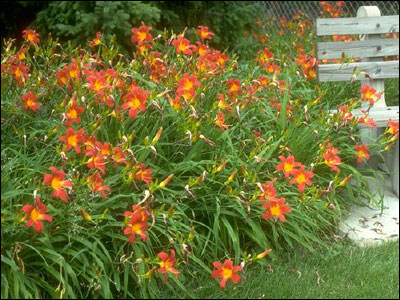
by Les Harrison | Oct 16, 2017
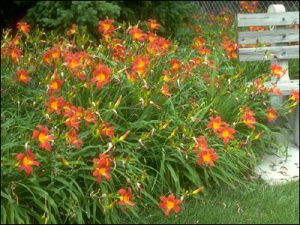
Daylilies in full bloom. Image credit UF / IFAS Solutions Website
“A penny saved is a penny earned” is the famously frugal advice from Poor Richard’s Almanac. The author Benjamin Franklin, elder statesman and founding father of the United States, offered this simple pearl of wisdom to 18th century American colonist to remind them to cautiously manage their assets.
This concept has met the test of time and had been resurrected in a variety of guises. Individuals, families, companies and governments have all applied a variation of this resource management concept, especially when their economic outlooks are challenged.
As basic as the idea is it can be applied to almost any situation, even the home landscape. Daylilies, the commonly encountered flowering ornamental in many 21st century gardens, is an excellent example of getting the most return for the least output.
The daylily is a popular flowering perennial with East Asian origins which has adapted well to Florida landscapes. Plants are available in a wide variety of growth habits, flower shapes and colors, including yellow, orange, red, pink, purple, near-white and shades and combinations of all of these.
Flowering starts in March for early-season bloomers with late-season cultivars starting in mid-May. The typical bloom period is about four to seven weeks, although some varieties bloom even longer.
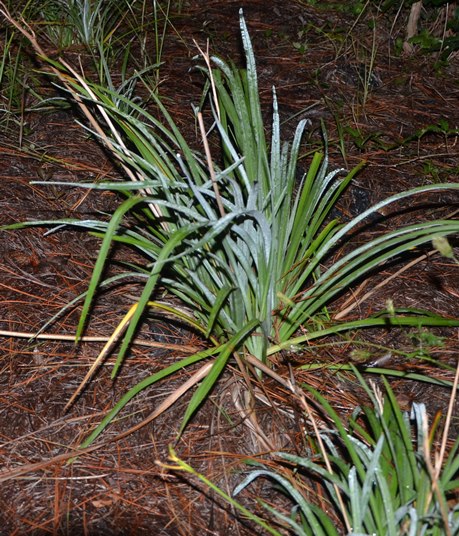
Daylilies are colorful and easy to grow. Propagation is easy this time of year, just dig, separate, and replant.
As their name accurately indicates, daylilies are members of the lily family, in the genus Hemerocallis. “Hemero” is Greek for “day” and “callis” for “beauty,” so the scientific name translates to beauty for a day.
For the adventurous eater, the flower buds and petals of daylilies are edible raw, boiled, stir-fried, steamed, stuffed, or battered and fried. Dried daylily petals, called “golden needles,” are used in numerous Chinese dishes.
Many of the modern varieties of daylilies available today have been developed from native Chinese species. Early settlers from Europe and Asia brought many of the original species with them to America.
Daylilies grow best in full sun or filtered shade. The darker colored red and purple varieties flourish better in partial shade, while light colored yellows, pinks and pastels varieties need full sun to bring out their best colors.
The filtered light level under pine trees is ideal for growing daylilies. Heavy shade should be avoided because it will cause thin, spindly growth and poor flowering.
The soil pH should be between 6.2 and 6.8, with 6.5 being optimal.
The soil of daylily beds should be topped with three to four inches of organic matter, such as peat, compost, or well-rotted manure. The amended soil should be mixed or tilled, leveled and then moistened.
Daylilies survive dry conditions well because of their extensive root systems. However, the number and size of blooms, plant growth, and overall vigor can be adversely affected by prolonged drought.
Daylilies multiply fairly rapidly and plant division is an easy way to propagate them for new locations in the home landscape or to share with friends. Division is best done immediately after the flowering season.
Dig the entire clump and shake or wash off the soil without damaging the roots. It is easy to see where the divisions can be made with smaller clumps being easily pulled free to establish a new planting.
The home gardener can expand and share the beauty of these perennials and only spend a little time to accomplish this. No doubt Ben Franklin and Poor Richard would approve.
For more information, check out this excellent publication titled “Daylilies for Florida”.
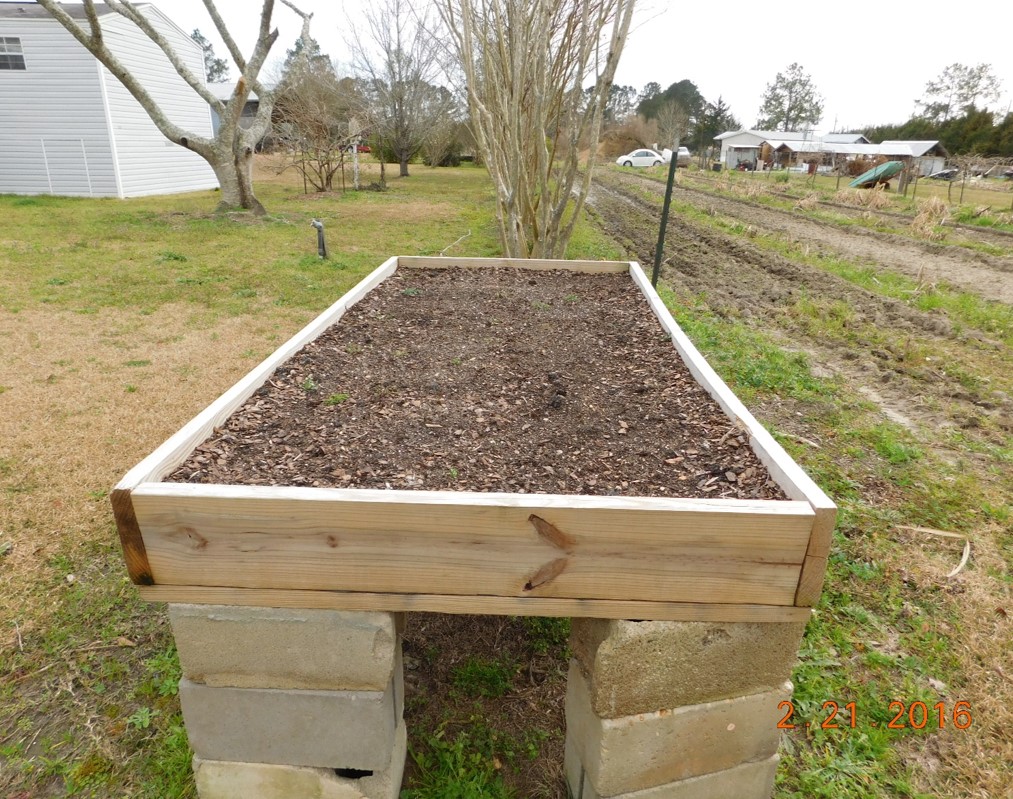
by Daniel J. Leonard | Oct 10, 2017
I had to do a hard thing last week. My battle-worn okra, eggplant and pepper plants that had produced so reliably since June and endured all the summertime challenges (heat, insects, disease, and a hurricane to name a few) were finally pulled out of my raised bed garden and discarded. A combination of lowered yields, increased insect pressure, and the fact that one can only eat so much okra in a calendar year sealed their fate.
However, before planting our cool-season veggie favorites, like those tender leafy greens and wonderfully crunchy carrots, there are a few things to do to get our raised beds in shape to give maximum yield performance and make growing a little easier.

Replenish the Soil
One of the main benefits of raised beds is the ability to grow in near-perfect soil conditions. If I was relegated to gardening in my yard’s less than ideal native sandy soil, I might have given up altogether by now and I suspect many of you would be in the same boat. Raised beds totally alleviate this problem and give gardeners the opportunity to grow in rich, fertile soil composed of your favorite homemade soil mixture (mine is two parts mushroom compost to one part aged pine bark) or commercial potting mix/compost. However, at the end of each growing season, you will notice you have a bit less soil in your beds than you did at the beginning. While frustrating, this is a natural process for soils rich in organic material – they naturally break down and decompose! So to give your veggies’ roots the maximum amount of growing space for the coming season, top off your beds with a quality soil/compost mix and till it in before sowing seed or setting out transplants.
Eliminate Competing Roots
If you have a mature tree anywhere near your raised bed garden, you are going to be in for a surprise when you till that new compost in! It turns out that tree roots like that rich, fertile raised bed soil just as much as vegetables do and will seek it out. It is not uncommon for mature trees to have root systems that stretch horizontally two to three times the height of the tree, meaning a 50’ oak tree could have roots growing well over a hundred feet away from its trunk! Therefore, unless you have a totally tree-free property, battling tree roots in your beds will be an ongoing issue. For instance, each fall, when I transition from warm season to cool season crops, I find that my neighbor’s Laurel Oak has filled all three of my raised beds full of feeder roots glad to be free of the infertile sand. This is a problem because those roots suck up vital water and nutrients meant for my vegetable crops, robbing them of reaching their full potential. It is good practice to thoroughly till your beds’ soil and remove as many of the competing roots as you can. Doing so will give your new plants a head start on becoming established before the competition returns.
Depleted soil and competition from tree roots are two of the biggest threats to your raised bed’s performance. By planning ahead and accounting for both of these things prior to planting your fall garden, you will be more likely to reap a larger yields when harvest time comes! For more information on raised bed vegetable gardening and other horticultural questions, contact your local UF/IFAS Extension Office. Happy fall gardening!
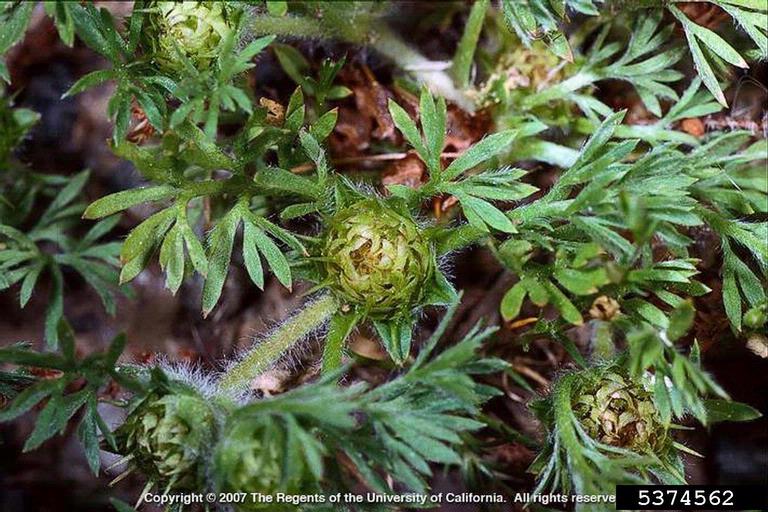
by Matthew Orwat | Oct 10, 2017
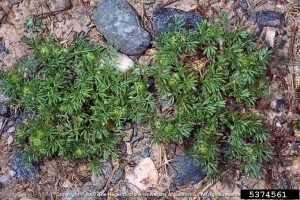
Burweed, Soliva Sessilis. – Image Credit: Joseph M. DiTomaso, University of California – Davis, Bugwood.org. Creative Commons License
On the top of my list of lawn related annoyances is stepping into a patch of burweed, Soliva sessilis, which is in the sunflower family and is also known as spurweed. The leaves are opposite along the stem and sometimes resemble parsley. The main ways in which burweed can irk the casual gardener are sticking to socks, sneaking in with the dog, or littering flower beds with its nuisance. It can also hide in the house and reappear when shoes are removed. This causes pain in both the foot and the ear.
Lawn burweed has been an especially noticeable problem in lawns. Over the years, extension offices throughout Northwest Florida have been fielding many questions and finding solutions to lawn burweed infestations!
Maintaining a healthy vigorous lawn will prevent weeds from taking over. If your lawn is reasonably healthy and only a few instances of this weed exist, try to mechanically remove them and encourage the lawn to outgrow them.
If an infestation of burweed occurred last year on a specific patch of turf, take note. The best time to apply pre-emergent herbicides to control burweed is in October, when nighttime temperatures drop to between 55-60 degrees F for a few consecutive nights. A widely used pre-emergence product for burweed control is isoxaben, which is sold under the brand name of Gallery as well as others. It prevents the weed from emerging from the ground when it germinates and can be used on St. Augustine, centipede, bahia and zoysia lawns, as well as in ornamental shrub beds. In northwest Florida, this herbicide needs to be applied in October for best results. A second application later in the season might be warranted. For more information about control, please consult this excellent article on lawn burweed management.
Now is the time to control burweed before it gets started. As temperatures cool burweed seed will germinate, as it is a winter annual. In cases where it is already coming up, control with post-emergent herbicide may be warranted.
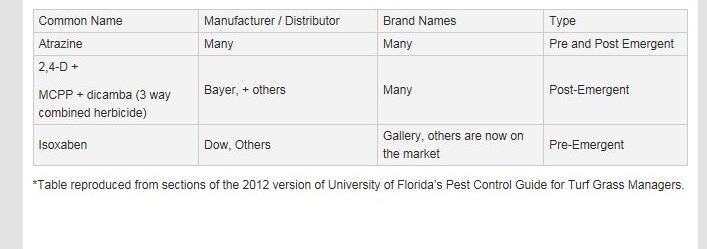
The active ingredients mentioned above are present in a variety of ‘trade name’ products* available from your local garden center, farm supply or co-op. Be sure to read label instructions carefully and contact your local extension office for any assistance. I hope all the northwest Florida lawn managers prevent burweed this fall so that lawns will be burweed free next spring.
Happy Gardening!
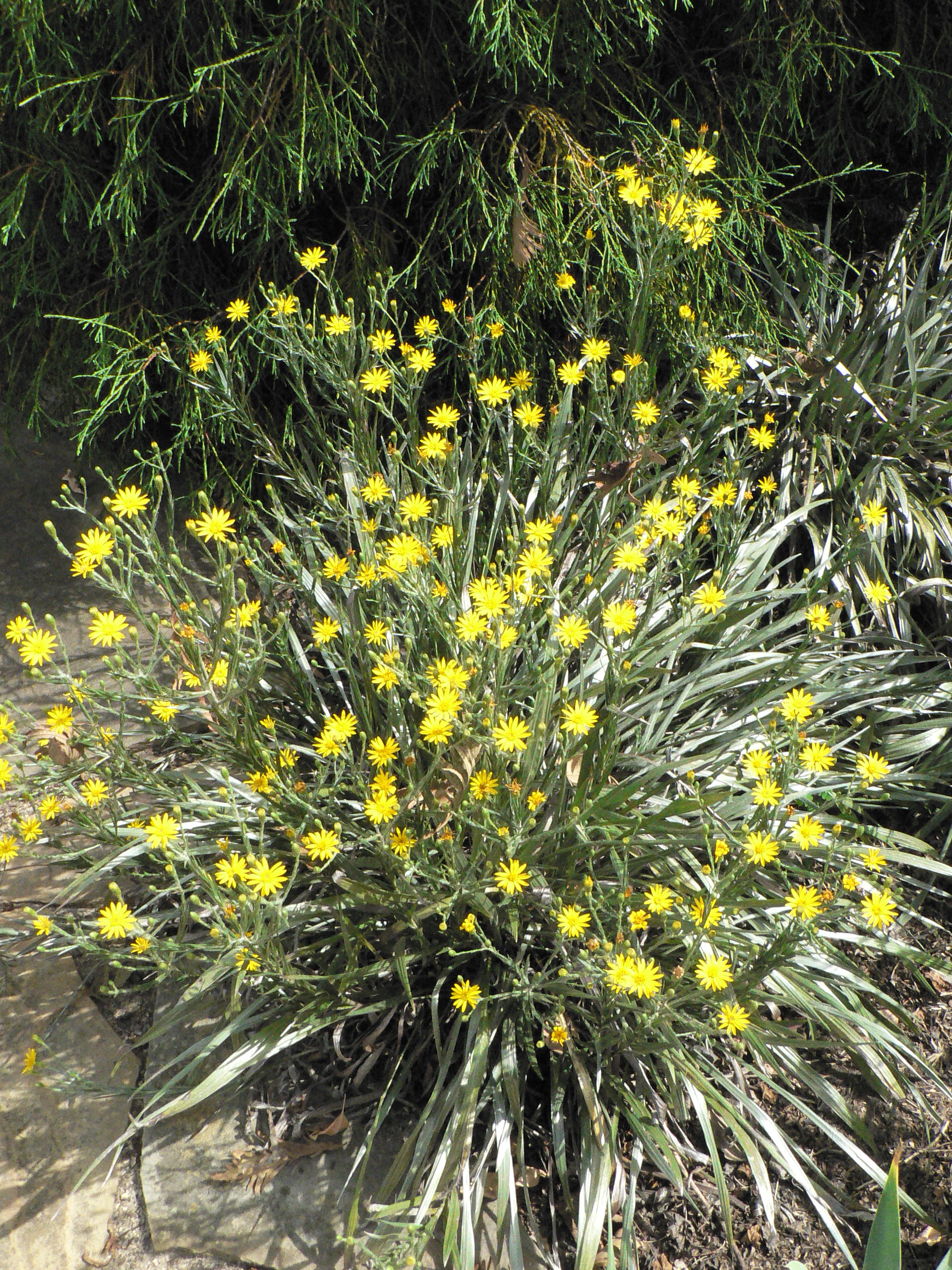
by Mark Tancig | Oct 9, 2017
The network of backcountry roads winding through north Florida offer pleasant views of rolling pastures, fields of cotton, old tobacco barns, and, occasionally, a scenic overlook of our local “hills”. Many of these roads follow the original trails blazed by early settlers, or even Native Americans. Traveling along these small roads during the late summer and fall, drivers are also presented with an abundance of wildflowers along the road. It’s fun to imagine travelers of past generations being awarded the same colorful displays in days of yore.
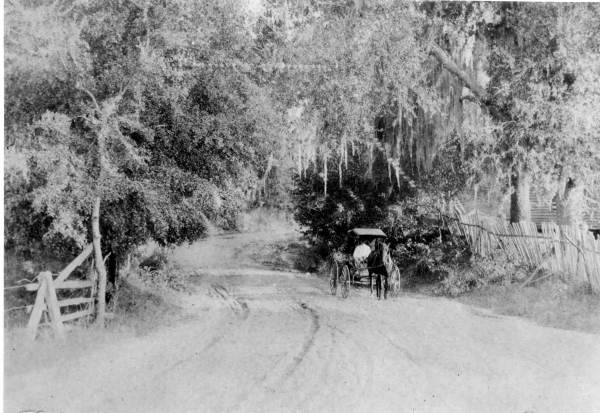
Traveling a country road in 1905 when they were all country roads! Likely enjoying same roadside wildflowers. Credit: State Archives of Florida – Hays.
Some of the most common roadside wildflowers of late summer include Spanish needles (Bidens alba), goldenrod (Solidago spp.), silkgrass (Pityopsis spp.), slender scratchdaisy (Croptilon divaricatum), goldenaster (Chrysopsis spp.), and, one that the early settlers wouldn’t have seen, showy rattlebox (Crotalaria spectabilis), an invasive, exotic species that was introduced in the 1920’s.
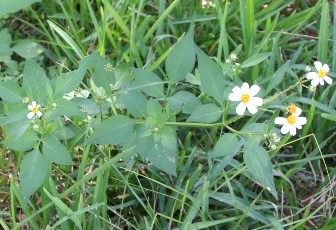
Spanish needles. Credit: Brent Sellers – UF/IFAS.
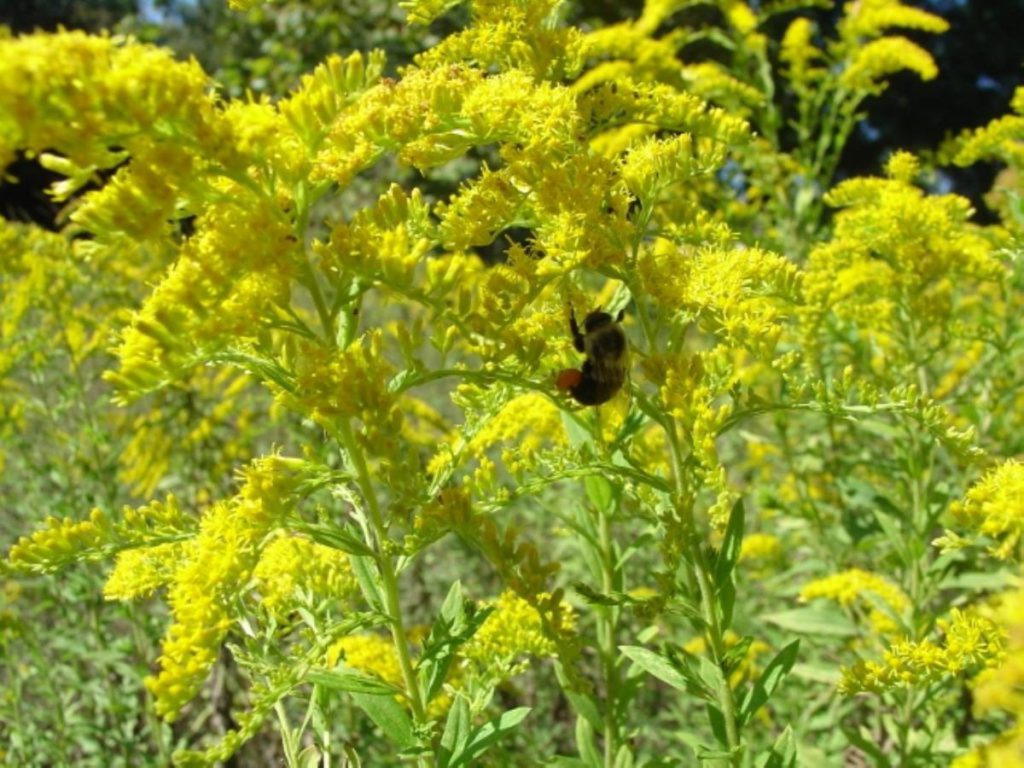
Goldenrod. Credit: Larry Williams – UF/IFAS.
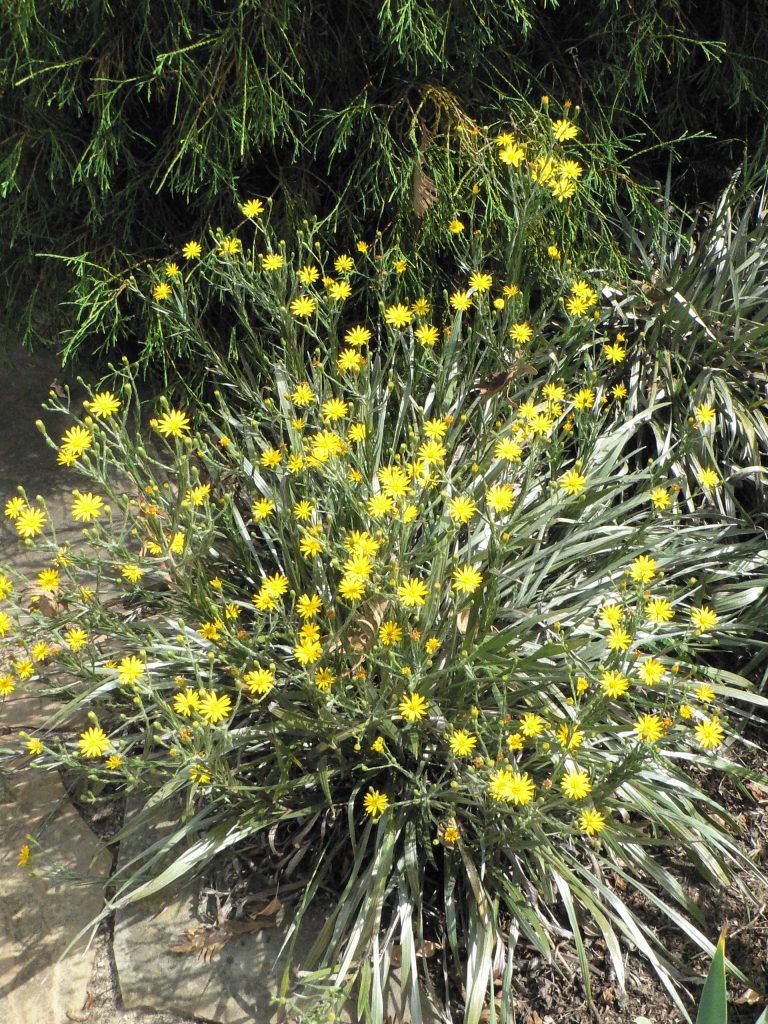
Silkgrass. Credit: JC Raulston Arboretum – NC State University.
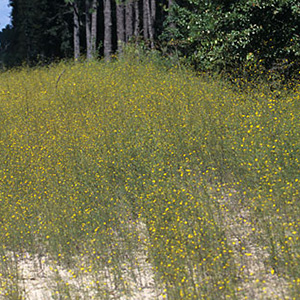
Scratch daisy. Credit: Center for Aquatic and Invasive Plants – UF/IFAS.
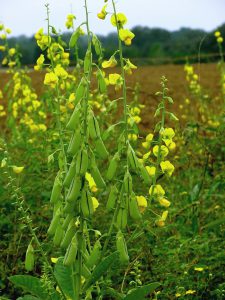
Showy rattlebox. Credit: Doug Mayo – UF/IFAS.
Many of these roadside wildflowers can also be found in home lawns and landscapes, usually in areas infrequently mowed, such as fence lines and field edges. Except for showy rattlebox, these roadside wildflowers are native species adapted to dry, disturbed sites, like roadsides. These native species provide ecosystem services to many native insects and other pollinators, including honey bees. Depending upon site particularities, allowing these plants to thrive in the residential landscape can provide similar ecosystem services and similar reward of color as is found along country back-roads.
While most folks would probably just consider these plants weeds, that determination depends upon an individual’s situation and each gardener’s opinion. In one yard, maybe it’s a weed, but along the roadside, it’s called a wildflower! Certainly, if left to set seed, these plants will spread. Mowing prior to seed maturity can help keep them in check while still getting a temporary show of color. Again, any showy rattlebox should be controlled since it is an invasive, exotic species that can invade natural Florida ecosystems and smother native plants. It’s also toxic to many animals if ingested.
North Florida’s roadside wildflowers are a pleasure see while cruising the back roads. If recognized and allowed to grow in residential landscapes, these plants can provide the same aesthetic and environmental benefits.
If you are interested in what’s growing in your yard, or local roadside, contact your county’s UF/IFAS Extension office.

by Sheila Dunning | Oct 2, 2017
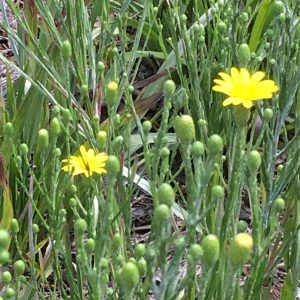
Silkgrass Pityopsis spp. Picture by: Sheila Dunning
Each fall, nature puts on a brilliant show of color throughout the United States. As the temperatures drop, autumn encourages the “leaf peepers” to hit the road in search of the red-, yellow- and orange-colored leaves of the northern deciduous trees.
Here in the Florida Panhandle, fall color means wildflowers. As one drives the roads it’s nearly impossible to not see the bright yellows in the ditches and along the wood’s edge. Golden Asters (Chrysopsis spp.), Tickseeds (Coreopsis spp.), Silkgrasses (Pityopsis spp.), Sunflowers (Helianthus spp.) and Goldenrods (Solidago spp.) are displaying their petals of gold at every turn. These wildflowers are all members of the Aster family, one of the largest plant families in the world. For most, envisioning an Aster means a flower that looks like a daisy. While many are daisy-like in structure, others lack the petals and appear more like cascading sprays.
So if you are one of the many “hitting the road in search of fall color”, head to open areas. For wildflowers, that means rural locations with limited homes and businesses. Forested areas and non-grazed pastures typically have showy displays, especially when a spring burn was performed earlier in the year.
With the drought we experienced, moist, low-lying areas will naturally be the best areas to view the many golden wildflowers. Visit the Florida Wildflower Foundation website, www.flawildflowers.org/bloom.php, to see both what’s in bloom and the locations of the state’s prime viewing areas.
And if you are want to add native wildflowers and other Florida-friendly plants to your landscape join the Master Gardeners for their Fall Plant Sale to be held Saturday, October 14 from 8 am to noon at the Okaloosa County Extension Annex located at 127 SW Hollywood Blvd, Ft. Walton Beach.
















